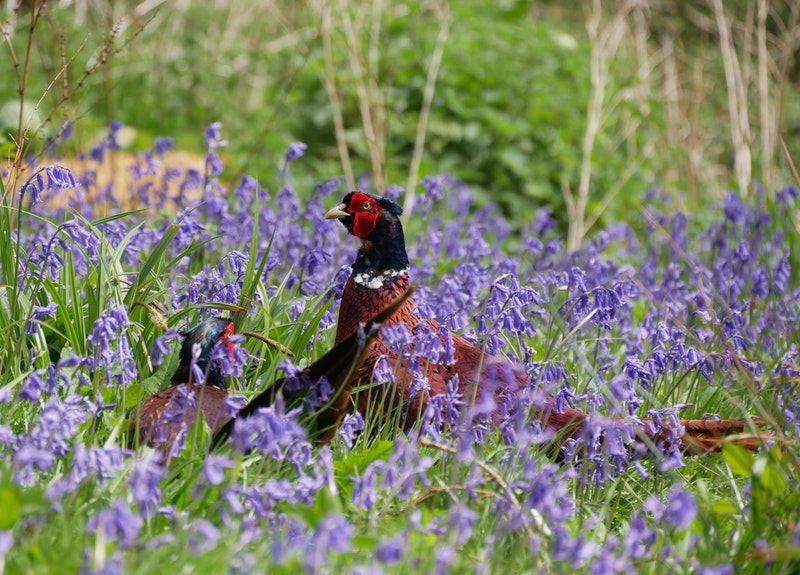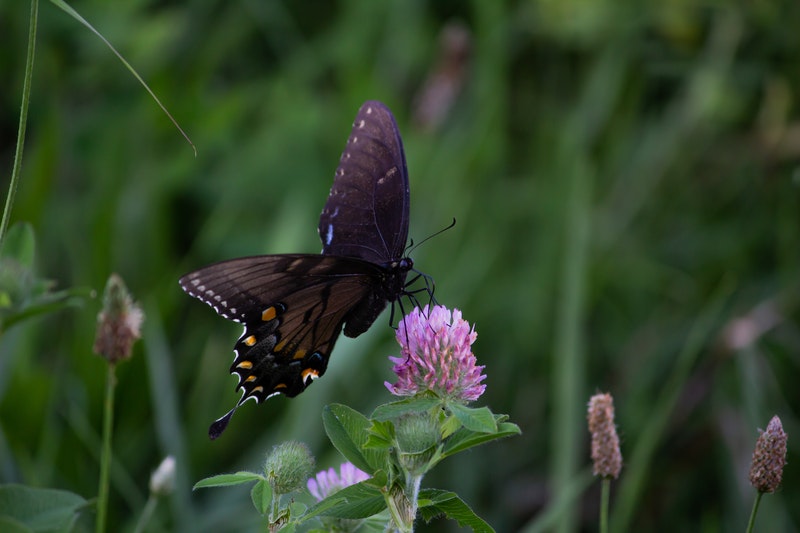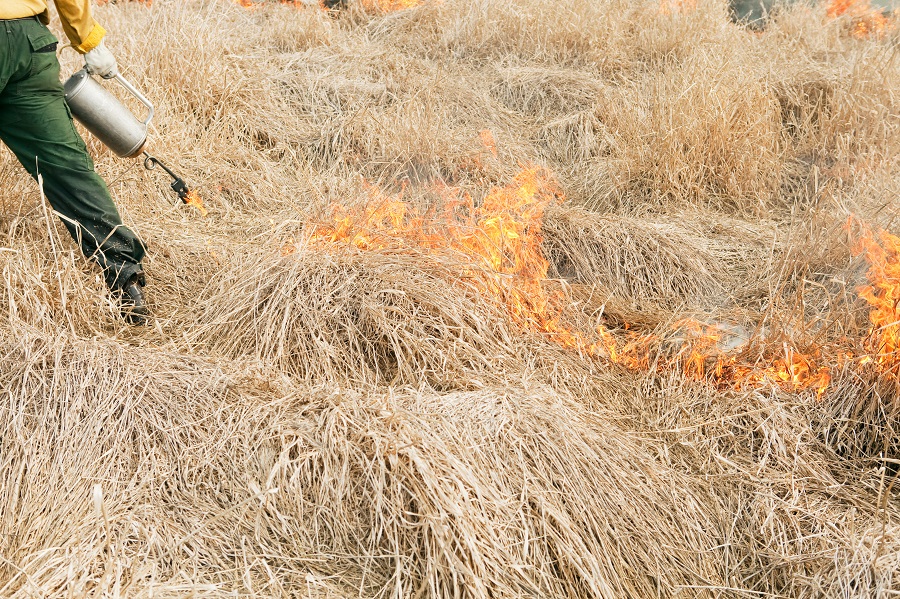Is your crop production or garden harvest down lately? Or is your property lacking the buzz and hum of pollinators? If so, you’re missing out on nature’s most productive workforce - pollinators! Consider planting a pollinator seed mix on your property this year to attract these winged wonders to boost your harvest to bumper-crop level.
At one time our land flourished with hundreds of native plants that sustained large quantities of pollinators and other beneficial insects. As more land is developed and cultivated, these native plants have been eradicated or replaced by swaths of monocropped fields and lawns. Returning the beauty and benefits of native plants and pollinators to your property is an investment that will yield for many years and in many ways.
How will Pollinators Help My Farm or Garden?
When most folks think of pollinators they usually picture bees, and specifically honeybees. But bees, butterflies, hummingbirds, moths, and even bats are all effective pollinators. They are an essential link in nature’s amazing plant reproductive cycle.
Pollinators provide the necessary service of transferring the flower-fertilizing pollen between plants. Fertilized flowers develop into the many edible fruits, veggies, and seeds we enjoy. Up to one-third of our diet is powered by pollinators. A pollinator’s superpower is turning flowers into food!
Increasing your pollinator population is proven to increase fruit set and quality in cultivated crops - up to 62% in some crops. Commercial growers know this and purchase or contract pollinators to improve their harvests. If your property is lacking the steady buzz of pollinator activity, it may surprise you how abundantly your crops will yield once you’ve invited a diverse pollinator community to the table.

It’s easy to visualize the transformation of a sunny yellow tomato flower into a juicy ripe tomato fruit or a tiny yellow-flowering vine into a row of watermelons for our enjoyment, but pollinators are also busy converting all sorts of wildflowers into fruit and seed for wildlife as well. Native fruiting species like beautyberries, hollies, and persimmons, and even ditch bank weeds like thistles, feed wildlife of all sizes. Pollinators fuel flower-producing food for deer, songbirds, ground-nesting birds like turkey and quail, and all manner of hungry wildlife.

How Can I Attract Pollinators?
There are easy ways to attract pollinators (and their benefits) back to your property. Like the rest of the animal kingdom, pollinators need four things in order to survive: food, shelter, water, and air. (We hope fresh air is a given.) Planting a pollinator seed mix is an excellent way to start building a prime pollinator habitat.
1. Clean Food
Also like us, pollinators need two types of food sources - protein (in the form of pollen) and carbohydrates (from plant nectar). It’s surprising to realize that not all flowering plants produce both nectar and pollen - and sometimes neither one! From a bee’s perspective, it can be a food desert.
To maintain a healthy pollinator population, you need to provide a consistent, accessible, and long-lasting food source. North America has over 400 species of native bees which range from tiny syrphid flies to chubby bumblebees. Many of these native pollinators are specialists - often depending on just one or two plant species for their entire lifecycle.
Diversity is the key to any healthy ecosystem. Our pollinator seed mixes are designed to attract a greater quantity and diversity of pollinators than individual plants can support. It’s an easy way to offer a full pollinator buffet!
Remember that most pollinators like bees and butterflies are insects. If you can’t avoid insecticides completely, be mindful of when and where you use them. Pollinators are most active at midday in sunny weather. If you must spray, plan on early morning or late evening and avoid pollinator habitats entirely. Because our pollinator seed mixes use pure, untreated seeds you can be confident that you are starting them off with a healthy, natural diet.
2. Water
Water sources are extremely important for pollinators, but it needn’t be fancy. A basic farm pond or well-tended bird bath suits them fine. If you don’t have a shallow creek or pond close by, pollinators will look for an alternative water source.
Drowning is a real issue for thirsty bees. If they settle on your livestock tank, add in some floating material (small twigs or slices of styrofoam pool noodles work great) or provide safe drinking platforms with wet sponges. These insect life rafts will keep your pollinator population safe and hydrated.
3. Shelter
Did you know that the majority of our native bees are ground dwellers? Providing them shelter requires leaving the ground undisturbed. Tilling or turning the soil damages brood-rearing nests, and frequent mowing removes essential blooms and can kill colonies. You have permission to keep the tractor in the shed. A low-maintenance pollinator habitat means less work for you and more real estate for them!

What is a Pollinator Seed Mix?
Pollinator seed mixes are combinations of flowering plant seeds selected to attract and feed a multitude of pollinator species. Deer Creek Seed offers several bulk wildflower seed and pollinator mixes with different blends of hardy annual and perennial native wildflowers and legumes to draw and sustain pollinators on your land. Choose from:
North American Shade Wildflower Seed Mix
Deer Proof Wildflower Seed Mix
All Perennial Wildflower Seed Mix

How Do I Choose The Right Pollinator Seed Mix?
- Consider your location and growing conditions. Full sun offers the most possibilities for blooming plants. But if you are shade-bound, take heart! We also offer a North American Shade Wildflower Mix. Is height an issue? Many of our pollinator blends mature to heights of up to three feet. We also offer a Low Grow Wildflower Mix for areas that need to keep it short.
- Decide Who You Want To Feed. If you are specifically interested in pollinators, you might prefer our Honey Bee Pollinator Mix or Deer Proof Wildflower Mix. While most of our seed mixes will attract multiple wildlife species, some are more targeted than others. If you want to attract as much wildlife as possible, consider our Native Wildflower and Forbs Mix (and add in additional grasses for grazing. More on that in a minute.)
- Decide what is your next crop? If you need the location again in a season or two, opt for an annuals-only blend. Setting up a permanent pollinator plot? Select a variety with a strong mix or pure blend of perennials.
For example, our Native Wildflower and Forbs Seed Mix blends first-year flowering annuals like corn poppies, candytuft, and partridge peas with perennial rebloomers like coneflowers, coreopsis, daisies, rudbeckia, prairie clover, and more. At maturity, these plants will reach upwards of 36” tall.
This colorful mix of blooming prairie plants will summerlong butterfly and bee forage to feed your pollinators. Flowers will form seed heads in late summer (to the delight of many birds) and eventually die back to the ground in winter. This mix is ideal for the wildlife enthusiast who wants a combination of near and long-term blooms for as many species as possible.

Where Should I Plant a Pollinator Seed Mix?
Remember that most of these seed mixes are intended to recreate the prairie once common in the Upper Midwest, so think long-term. Most of our pollinator seed mixes need full sun and wide-open space but aren’t terribly fussy about soil fertility. Because many of them are native species, they are well adapted to our growing conditions including heat, cold, and drought.
Keep in mind that your budding prairie meadow isn’t a manicured lawn. This wild habitat will be tall, airy, and full of life. Pollinator habitat plantings are ideal for hedgerows, erosion concerns, and utility easements. Just remember to post signage identifying your pollinator habitat so the area isn’t accidentally mowed or sprayed.
Many native bees have a limited flight range (some less than 100 yards) so if you’re counting on them to boost your crop production, consider planting a pollinator strip between fields or near your garden. As a side benefit, you’ll get to enjoy the beauty and life alive on your land every time you pass by.
Pollinator Habitats are Useful to Attract Bees, Butterflies, and Wildlife
Plant it and they will come! The magic that pollinators perform in crop production also draws in other wildlife seeking this abundant forage buffet. One popular use for pollinator seed mixes is wildlife conservation areas.
Adding either our Upland or Lowland Native Grass Mix to your pollinator seed mix will add grazing forage to your pollinator habitat to feed and house even more wildlife. The combination of grazing forage and mid-level plant canopy creates the perfect environment to hide napping fawns and fledgling turkey poults.
And while pollinator plants attract beneficial insects for their pollinating skills, these insects also join the diverse ecosystem and become part of the food chain as a healthy diet for turkeys, amphibians, and even fish. Pollinator habitats are often part of prairie restoration and CRP plantings. Be sure to check with your local NRCS office on the availability and requirements for program participation.

When is the Best Time to Plant a Pollinator Seed Mix? Should I Fertilize My Pollinator Seeds at Planting?
Many native wildflower seeds benefit from a cold dormant period and/or the rough and tumble freeze-thaw cycle of winter to break down their study seed coating (in processes called stratification and scarification). As such, pollinator seed mixes are best planted in the fall of mild climates or in late winter or as soon as the ground can be worked in spring throughout the Upper Midwest.
Deer Creek Seed’s pollinator mixes have not been stratified, so up to 25% of the seed won’t germinate until the following year without intervention. Read more about seed dormancy and stratification here. You can short-cut the stratification process by chilling seed for four to six weeks before planting or just by planting in the fall. In either case, do your soil prep in the late summer or early fall so the ground is ready to be seeded when you are.
We always recommend starting with a soil test, especially to gauge pH. Add any lime while prepping the soil. Wildflowers prefer neutral or slightly acidic soils of 6.0-7.0 pH. These native bloomers are well adapted to our soils and require little supplemental fertilizers. Nitrogen should even be avoided, until plants have reached at least four inches tall, to avoid forcing competitive weed flushes. After year two, a mid-season application of a balanced fertilizer will support ongoing healthy roots and shoots.
Because our bulk pollinator seed mixes are a combination of annuals and perennials, you can expect some blooms the first year and an increasing number in years two and three as more perennial species become established. Starting year two, you can expect blooms from May until frost.

How to Plant A Wildflower Pollinator Seed Mix
Perennial seeds are slow starters and need every advantage to outcompete weeds. Drilling into a terminated cover crop or sod is preferable. Different seed blends will have different sowing depth and spacing requirements. Be sure to check the planting information for the specific mix you select. If mixing grass and pollinator seed, opt for the shallowest drill depth specified.
If you are broadcast spreading, try to start with a stale seedbed by solarizing, tarping or otherwise terminating the existing crop in late summer. After two weeks, lightly disk the area and water it to initiate weed germination. Flame weed or treat the area with a broad spectrum herbicide like glyphosate and then plant your pollinator seed mix within one to two days. We recommend increasing your seeding rate and rolling or lightly dragging to increase seed to soil contact.
Because birds are fans of wildflower seeds (which is partly why we plant them) you will want to lightly cover the seed or use bird scare tactics like flash tape, pie pans, or a scarecrow. If your planting area is small enough, you can foil the birds by covering the seeded ground with floating row cover and remove once the seed has safely sprouted.
What is the Seeding Rate?
Deer Creek Seed sells our pollinator seed mixes in bulk pounds. Seeding rates vary by the mix and by which seeding method you use.
Seeding rate x #acres = amount of seed to purchase
Ex: If you are broadcast seeding our Native Wildflower & Forbs Seed Mix and want to cover 3 acres your formula would be 6 x 3 = 18. So you would order 18 bulk pounds of seed for the initial seeding. But while you are at it (and it is in stock), go ahead and buy an additional 15-20% for spot reseeding and supplemental seeding in year two. Just make sure to store your seed in a cool, dark place safe from nibbling mice.

Are Pollinator Seeds Sensitive to Herbicides?
Yes! Most pollinator plant species are forbs - in the same category as many broadleaf weeds. Spray them with herbicide and they are toast. It’s best to invest time in your initial soil prep and start with a stale seedbed if at all possible.
Minimize soil disturbance at all times and spot spray herbicides judiciously if needed. Realize that any overspray or drift will injure seedlings and potentially require spot reseeding. Early weed control is essential to establishing a thriving pollinator habitat. The work you put in now will result in a dense canopy that will reward you with significantly less effort as the plants become more established.
Long Term Pollinator Habitat Maintenance
Our pollinator seed mix is designed to provide years of bloom. Perennial species will return and expand each year, and most annuals will freely reseed. If you’ve successfully managed weeds early on, maintenance becomes a breeze after two to three years once the perennials have established. So focus on weed control for the first one to two years.
A single annual fall mowing will help shatter and disperse seeds and return organic material to cover the soil. Consider a light fall reseeding for the first one to two years to keep the annual blooms well stocked until the perennials fill the plant canopy. And stay vigilant on weed control those first few years.
One of the best ways to reinvigorate your established pollinator habitat is with prescribed fire. Burning is a natural prairie phenomenon and many wildflower species have adapted to quickly and more abundantly repopulate after a fire. Once your pollinator habitat is established (years three to five), consider using a three-year strip rotation of burning. Mentally or physically divide your pollinator habitat into three roughly equal sizes and burn one per year.
Maintaining pollinator plants through rotational burning is preferable to periodic full burns. It maintains the bulk of your pollinator habitat which is important to insect species that have limited forage ranges.

Dividends For Years To Come
Planting a pollinator seed mix is a great way to revitalize your land’s entire ecosystem. In addition to creating fruit and veggies for your family or farm, the pollinators’ work feeds and attracts wildlife for you to enjoy as well.
The more abundant and diverse biology you bring to your property, the more it will return to you. Planting pollinator seed mixes will improve the aesthetics and enjoyment of the outdoors for you and all the creatures that call it home.

Additional Resources:
- USDA NRCS Pollinator Habitat installation and CRP job sheet. An excellent resource with photos on pollinator habitat installation and maintenance. Check with your local agency for availability and updates to the program.
- Wisconsin Department of Natural Resources’ Saving Native Pollinators website. A very thorough resource for identifying beneficial insects and managing for native pollinator conservation.
- NRCS fact sheet on seeding pollinator plots. An excellent resource for bed preparation, seeding techniques, seed identification, and management strategies. Note that their management plan is for a perennial plot and recommends frequent early-season mowing. Weigh the weed control benefits with the number of annual seedlings that may be affected by mowing.
- Xerces Society’s Bring Back the Pollinators website with interactive maps, pollinator next site ideas, lists of pollinator-friendly flowers, and pollinator habitat signage.
- Oregon NRCS Introduction to Insect Pollinators regional identification guide, designed for the pacific northwest but useful for many areas that share the same species
- Pollinator.org’s Pollinator Partnership eco-regional planting guides allow you to input your zip code or Canadian province for a localized guide to flowers and habitat issues pertinent to your area.
- Xerces Society’s Attracting Native Pollinators book. An excellent and comprehensive guide on identifying native insects and creating safe foraging areas.
- Midwest Invasive Plant Network has a useful database of hard-to-control invasives and management strategies.
- USDA NRCS Dormant Seeded Pollinator-Friendly Planting study compares several species mixes and fall seeding strategy.
- University of Wisconsin Weed Science Extension Interactive Weed Identification tool. An excellent resource for properly identifying weed species.
- University of California Davis’ Soil Solarization guide for a non-chemical weed management strategy.



